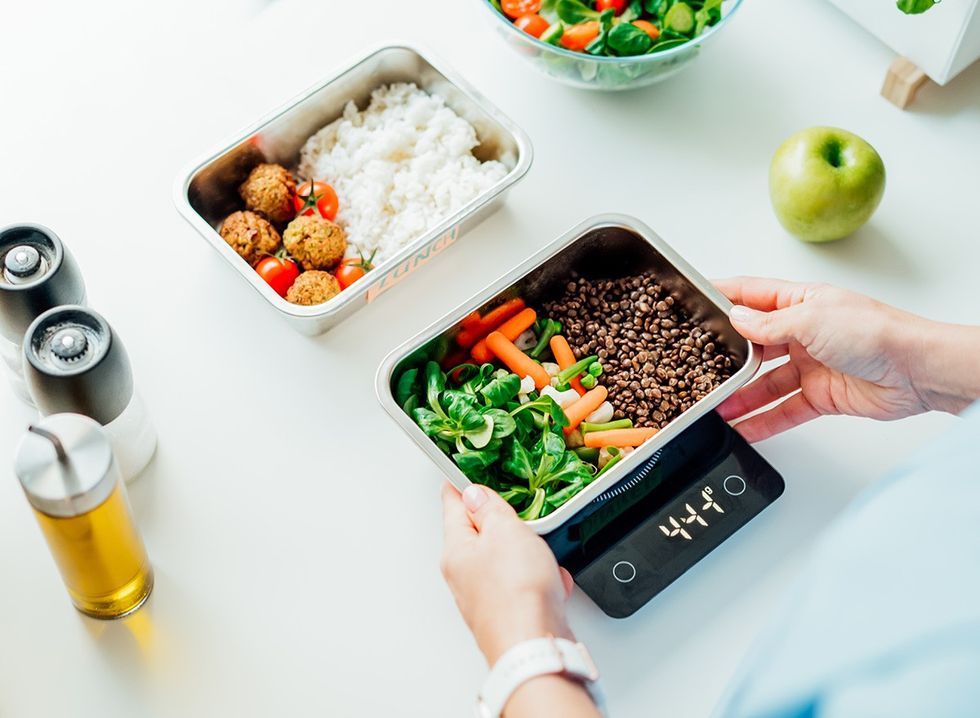If you are trying to lose weight, walking is a great workout. “Walking offers numerous advantages, and its accessibility requires minimal experience, making it simple to start,” explains Erin Beck, NASM CPT and Director of Training and Experience at STRIDE Fitness. “It aids in maintaining a healthy weight and enhances cardiovascular and pulmonary fitness, crucial for lowering the risk of serious health issues like heart disease, diabetes, and stroke.” It’s also great for your mental health, she notes. “Walking also serves as an effective method to alleviate stress, boost mood, and foster connections with friends who share the activity.” If you are trying to lose weight by walking, these 15 expert-endorsed tips will help.
Pair It with Strength Training

“Training cardio is great,” says Erin Beck, Director of training and expertise at STRIDE Fitness. “It torches calories while you're doing it, and the endorphin release is amazing afterward.” To maximize the burn, she recommends pairing it with strength training. ‘The more muscle your body has on it, the more fat and calories you'll burn on the daily, regardless of your cardio sessions. So if you're trying to lose weight, walking can actually be a great tool; you just have to use it correctly,” she says.
Add Incline on the Treadmill

Beck also recommends adding an incline. “Walk your usual walking pace (usually around 3.5 mph), but do it at a 4% incline. Then try it at a 7% incline,” she says. “Here's why: Your body has to work harder to get up those hills, and you're building muscle to do it. This will increase your calorie burn, even after your workout is over.” According to Beck, every 3% you add to your incline is the equivalent effort of adding 1 mph to your speed. “This means that your 3.5mph at 7% incline is the equivalent to running almost 6 mph,” she notes.
Walk Up a Hill

If you don't have a treadmill, “just find a hill to hike up and down,” recommends Beck. “You'll earn that same calorie-torching effect.”
Take a Nature Walk

If you get bored walking on a treadmill or around your neighborhood, find a great walking path out in nature, suggests Darnell Cox, Leading healthy aging expert with a master's in Gerontology at Live Young Lifestyle. “Nature walks are a good way to get the benefits of being outdoors along with the physical activity of going on a walk,” he says. “Spending time outdoors also adds to the mental health benefits since it may lessen depression and anxiety symptoms. Being in a relaxing outdoor setting helps to calm the nervous system, improve mood, and increase overall sense of well-being. I recommend that my clients simply get outside and go for a walk in their neighborhood.”
Add Intervals

Add some bouts of increased speeds to your walk. “To maximize weight loss during walking, I like to alter my pace after a few blocks to get in some light interval training,” recommends Cox. “So every 3-4 blocks, I increase my leisurely pace to a brisk walk. Movement is medicine, so even a brisk walk gets the body active and ready to burn calories.”
Wear a Heart Rate Monitor

Tori Hartline, DC, MS, Pediatric and Prenatal Chiropractor at Sunlife Chiropractic, recommends using a heart rate monitor to ensure you stay in a fat-burning mode. “Exercise intensity is categorized into heart rate zones 1 to 5. Aerobic exercise is low to moderate, sustainable exercise achieved at heart rate zones 1,2 and 3 (50-85% of max heart rate). Examples include walking, yoga, or running. It is recommended to use a heart rate monitor to accurately determine your heart rate zone while exercising. Fat is utilized as the primary fuel source for aerobic exercise. Therefore, walking burns fat which is an important factor for weight loss,” she says.
RELATED: The Ultimate Guide to Getting Fit as a Pear Body Type
Start Slow

Hartline also recommends setting small walking goals and increasing them as you go along. “I recommend people begin with low-intensity, easily implementable, and enjoyable exercise. Walking is a wonderful way to achieve this because it is accessible and implementable in our daily lives,” she says. “Often, when starting a new exercise routine, people will set aggressive goals. Change is scary to the brain; therefore, the most successful lifestyle changes are done when ‘the gap’ presents a challenge, but the brain sees it as possible. So, assess your current activity level and determine what specific, measurable, achievable, relevant and time-based (SMART) goals are for you,” she continues. “In a world filled with stress, most people should focus on low-impact exercise for stress reduction versus high intensity, stress-inducing exercise.”
Change Your Speed Based on Your Situation

Erin Beck, NASM CPT and Director of Training and Experience at STRIDE Fitness explains that the speed of your walk is what will ultimately impact your cardiovascular health. However, you can alter your speed based on your situation that day. “Choosing your speed should align with your individual goals and comfort level. It's essential to prioritize safety over competition,” she says. “Typically, a speed of 2 to 4 mph is regarded as a normal walking pace on a treadmill. If you're multitasking or prefer to remain composed during a significant Zoom call, opt for the lower end of the spectrum. If you're fully locked in to a task and are looking for a slight exertion, consider increasing the speed (within reason). Begin at a leisurely pace and gradually adjust as you grow more accustomed. Eventually, you'll discover the ideal range that suits your cardio exercise needs.”
Have the Right Gear

Malia Frey, ACE-certified health coach, personal trainer, and author of Macro Diet for Dummies, recommends using walking-approved accessories. “You don't need special tools for walking except dedicated walking shoes,” she says. Other accessories, such as a pedometer, water bottle, or moisture-wicking clothing, can help make your workout more comfortable. One thing she doesn’t recommend? Ankle weights, “as they can increase your chance of injury,” she says.
Add Core and Bodyweight Exercise to the End of Your Walk

Add some core and bodyweight exercises, as recommended by Frey. “When you finish your walking session, take 5 minutes to do a few 30-second planks, 10 to 15 lunges, and 10 to 15 push-ups to turn your walking session into a total body workout.”
Consider Your Walk a Supplemental Workout
Shutterstock
Frey also suggests making your walk supplemental to another workout program and not substituting your daily steps for one. “Some people start a walking workout program only to find out that they get lazier throughout the rest of the day. The result? Your daily step count actually diminishes, therefore reducing the weight loss benefits,” she says. The fix? “Challenge yourself to reach 10,000 ‘non-exercise’ steps per day, and add your walking workout as a bonus.”
Timing of Your Walks Matters
Shutterstock
Frey suggests timing your walking workout during high-stress or boring times of the day. “If you can plan your workouts for the time of day when you might be most tempted to head to the fridge or eat mindlessly, you'll kill two birds with one stone,” she says. “You burn extra calories while also helping yourself to stick to your calorie goals.”
Be Consistent

Optimize consistency. “Incentivize yourself to keep yourself on track,” says Frey. “Have your spouse drive you to an end destination and make your workout a walk home. Engage in competitions with long-distance friends or family to complete 3 to 5 walking workouts per week. Join a walking group or connect with friends who have similar goals.”
RELATED: This Plan Is How to Lose 5 Percent Body Fat In 2 Weeks
Don’t Neglect Your Diet

Remember, if you are trying to lose weight, you also need to pay attention to your diet. “Always pair your walking workout with a macro-based diet,” says Frey. “Exercise is great for your body, but when it comes to weight loss, diet makes a bigger impact than exercise. Follow a healthy macro-based diet to get balanced nutrition for optimum results. Macro Diet for Dummies is a great resource for beginners, and it is available on Amazon or at your local bookstore.”
Give Yourself Challenges

Mini challenges on your walk can motivate you. “Use a timer or incorporate fartleks to make your walking workout more intense. Fartleks are unstructured intervals (often used by runners). For instance, you might use scenic elements to set up your fartlek. Walk briskly to the next tree, then slow down for a minute to catch your breath. Repeat several times,” says Frey.
Listen to Music

Give your walk a soundtrack. Research has found that listening to music while you walk can improve speed and endurance, making it more likely that you will walk faster and longer.
Find a Walking Buddy or Group

If you get bored walking alone, find a walking buddy or a walking group. Research supports that there are many benefits to walking with others, mainly because it makes walking more fun and adds an accountability factor to the mix.
Take Mini Walks

Even if you don’t have 30 minutes to dedicate to taking a walk, going for mini walks throughout the day can help you achieve your step goals. “Instead of sitting and waiting while your child is at sports practice, walk around the field,” the CDC suggests.
Park Further Away or Walk Instead of Drive

Another way to sneak steps in to accelerate weight loss is to walk more and drive less. “Stop circling parking lots looking for a close spot. Park further away and walk briskly to your destination. You could get a few more minutes of physical activity by walking around the entire parking lot before going inside,” the CDC recommends.
RELATED: 15 Quick Ways to Lose Body Fat Percentage in a Week
Track Your Steps

Don’t forget to track your steps. Use an activity monitor to tally up your daily steps and keep a record of them, the CDC suggests. On their website they offer examples of weekly physical activity schedules.
💪🔥Body Booster: Start your walking routine with small, achievable goals and gradually increase the intensity and duration over time. Set goals that challenge you but are still manageable, and focus on low-impact, stress-reducing walks.
















 Courtney Black/Instagram
Courtney Black/Instagram




 I'm a Nutritionist and These 9 High-Protein Snacks Keep My Clients Full While Losing 50 Pounds
I'm a Nutritionist and These 9 High-Protein Snacks Keep My Clients Full While Losing 50 Pounds
 Shutterstock
Shutterstock 2. Processed FoodsShutterstock
2. Processed FoodsShutterstock Shutterstock
Shutterstock Shutterstock/Prostock-studio
Shutterstock/Prostock-studio Shutterstock
Shutterstock Pro TipsShutterstock
Pro TipsShutterstock Shutterstock
Shutterstock Shutterstock
Shutterstock Shutterstock
Shutterstock Shutterstock
Shutterstock Don’t Drink as Much AlcoholShutterstock
Don’t Drink as Much AlcoholShutterstock Most Women on GLP-1s Are Making a Few Common MistakesShutterstock
Most Women on GLP-1s Are Making a Few Common MistakesShutterstock Soda and Sugary DrinksShutterstock
Soda and Sugary DrinksShutterstock Shutterstock
Shutterstock Eat BreakfastShutterstock
Eat BreakfastShutterstock And Improve Insulin SensitivityShutterstock
And Improve Insulin SensitivityShutterstock Belly Flab Strip Tip: Sugar and Fat Calories Leave Its Mark on Your BodyShutterstock
Belly Flab Strip Tip: Sugar and Fat Calories Leave Its Mark on Your BodyShutterstock Shutterstock
Shutterstock The Drugs Mimic the GLP-1 Hormone Naturally Produced by the BodyShutterstock
The Drugs Mimic the GLP-1 Hormone Naturally Produced by the BodyShutterstock 3. Deep-Fried ItemsShutterstock
3. Deep-Fried ItemsShutterstock